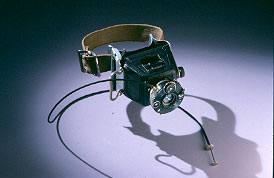Unidentified photographer / artist
n.d.
Howard ankle camera
National Museum of American History, Smithsonian InstitutionSmithsonian National Museum of American History (Object ID: PG*7107)
At the National Museum of American History the camera is listed as a Leica but it doesn't look like one. It has been suggested that the camera was a French Redux 4.5 x 6 cm plate camera made by G. Fournier from 1927. (12 January 2015, with thanks to Ira Cohen, Historic Cameras group, Facebook and Todd Gustavson, George Eastman House)
Howard Ankle Camera - The National Museum of American History
americanhistory.si.edu/collections/search/object/nmah_875015
(Accessed: 12 January 2015)
Curatorial description
Press cameras were forbidden from the prison execution chamber in Ossining, New York, where Ruth Snyder was to be electrocuted on January 12, 1928, for the murder of her husband. Editors at the New York Daily News believed it their duty to have both a journalist and photographer cover this event. Since all witnesses to the execution would be searched and frisked upon entry to the chamber, the newspaper planned their coverage well in advance.
One month before Snyder's execution, editors in New York enlisted the help of Chicago Tribune photographer Thomas Howard to prepare for their news coverage. Howard, who would not be recognized by New York prison officials, was brought to New York a month before the execution. He stayed in a hotel practising making exposures with this modifyed miniature plate camera. He strapped the camera to his ankle with a long cable release run up his trouser leg into his pants pocket. He lifted the pant leg to take a photograph.
Howard gained entry to witness Snyder's electrocution, achieving a slightly blurred image documenting the horror of the scene. The New York Daily News donated the camera to the Smithsonian in 1963.
LL/6629
